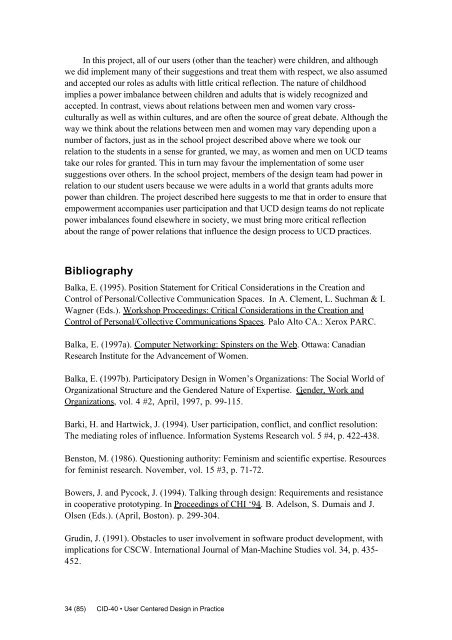User Centered Design in Practice - Problems and Possibilities
User Centered Design in Practice - Problems and Possibilities
User Centered Design in Practice - Problems and Possibilities
You also want an ePaper? Increase the reach of your titles
YUMPU automatically turns print PDFs into web optimized ePapers that Google loves.
In this project, all of our users (other than the teacher) were children, <strong>and</strong> although<br />
we did implement many of their suggestions <strong>and</strong> treat them with respect, we also assumed<br />
<strong>and</strong> accepted our roles as adults with little critical reflection. The nature of childhood<br />
implies a power imbalance between children <strong>and</strong> adults that is widely recognized <strong>and</strong><br />
accepted. In contrast, views about relations between men <strong>and</strong> women vary crossculturally<br />
as well as with<strong>in</strong> cultures, <strong>and</strong> are often the source of great debate. Although the<br />
way we th<strong>in</strong>k about the relations between men <strong>and</strong> women may vary depend<strong>in</strong>g upon a<br />
number of factors, just as <strong>in</strong> the school project described above where we took our<br />
relation to the students <strong>in</strong> a sense for granted, we may, as women <strong>and</strong> men on UCD teams<br />
take our roles for granted. This <strong>in</strong> turn may favour the implementation of some user<br />
suggestions over others. In the school project, members of the design team had power <strong>in</strong><br />
relation to our student users because we were adults <strong>in</strong> a world that grants adults more<br />
power than children. The project described here suggests to me that <strong>in</strong> order to ensure that<br />
empowerment accompanies user participation <strong>and</strong> that UCD design teams do not replicate<br />
power imbalances found elsewhere <strong>in</strong> society, we must br<strong>in</strong>g more critical reflection<br />
about the range of power relations that <strong>in</strong>fluence the design process to UCD practices.<br />
Bibliography<br />
Balka, E. (1995). Position Statement for Critical Considerations <strong>in</strong> the Creation <strong>and</strong><br />
Control of Personal/Collective Communication Spaces. In A. Clement, L. Suchman & I.<br />
Wagner (Eds.). Workshop Proceed<strong>in</strong>gs: Critical Considerations <strong>in</strong> the Creation <strong>and</strong><br />
Control of Personal/Collective Communications Spaces . Palo Alto CA.: Xerox PARC.<br />
Balka, E. (1997a). Computer Network<strong>in</strong>g: Sp<strong>in</strong>sters on the Web . Ottawa: Canadian<br />
Research Institute for the Advancement of Women.<br />
Balka, E. (1997b). Participatory <strong>Design</strong> <strong>in</strong> Women’s Organizations: The Social World of<br />
Organizational Structure <strong>and</strong> the Gendered Nature of Expertise. Gender, Work <strong>and</strong><br />
Organizations , vol. 4 #2, April, 1997, p. 99-115.<br />
Barki, H. <strong>and</strong> Hartwick, J. (1994). <strong>User</strong> participation, conflict, <strong>and</strong> conflict resolution:<br />
The mediat<strong>in</strong>g roles of <strong>in</strong>fluence. Information Systems Research vol. 5 #4, p. 422-438.<br />
Benston, M. (1986). Question<strong>in</strong>g authority: Fem<strong>in</strong>ism <strong>and</strong> scientific expertise. Resources<br />
for fem<strong>in</strong>ist research. November, vol. 15 #3, p. 71-72.<br />
Bowers, J. <strong>and</strong> Pycock, J. (1994). Talk<strong>in</strong>g through design: Requirements <strong>and</strong> resistance<br />
<strong>in</strong> cooperative prototyp<strong>in</strong>g. In Proceed<strong>in</strong>gs of CHI ‘94 . B. Adelson, S. Dumais <strong>and</strong> J.<br />
Olsen (Eds.). (April, Boston). p. 299-304.<br />
Grud<strong>in</strong>, J. (1991). Obstacles to user <strong>in</strong>volvement <strong>in</strong> software product development, with<br />
implications for CSCW. International Journal of Man-Mach<strong>in</strong>e Studies vol. 34, p. 435-<br />
452.<br />
34 (85) CID-40 • <strong>User</strong> <strong>Centered</strong> <strong>Design</strong> <strong>in</strong> <strong>Practice</strong>

















